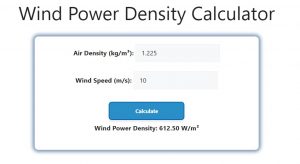About Wind Power Density Calculator (Formula)
Wind power density (WPD) is a key measure in determining the potential of wind energy at a particular site. It quantifies how much wind energy is available per unit area and can be used to estimate the efficiency of wind turbines. Understanding wind power density is vital for renewable energy projects, helping engineers and planners select the best locations for wind farms and optimize turbine placement to maximize energy output.
Formula
The formula for calculating wind power density is:
Wind Power Density (WPD) = 0.5 * Air Density (AD) * Wind Speed (WS)³
Where:
- WPD is the wind power density.
- AD is the air density, typically measured in kilograms per cubic meter (kg/m³).
- WS is the wind speed, measured in meters per second (m/s).
- The wind speed is raised to the power of three (cubed), indicating that small increases in wind speed lead to significant increases in power density.
How to Use
- Measure Air Density (AD): You can obtain the air density value from weather stations, or use an average value of 1.225 kg/m³ at sea level under standard conditions.
- Measure Wind Speed (WS): Use an anemometer or obtain wind speed data for the location in meters per second (m/s).
- Input Values into the Calculator: Enter the air density and wind speed data.
- Calculate Wind Power Density: The calculator will compute the WPD, providing an estimate of how much wind energy is available in watts per square meter (W/m²).
Example
Let’s calculate wind power density at a location with an air density of 1.225 kg/m³ and a wind speed of 10 m/s.
WPD = 0.5 * 1.225 * (10)³
WPD = 0.5 * 1.225 * 1000
WPD = 612.5 W/m²
This means that 612.5 watts of wind energy are available per square meter at the given location.

FAQs
- What is wind power density?
Wind power density measures the amount of wind energy available per unit area, typically in watts per square meter (W/m²). - Why is wind power density important?
It helps assess the potential for wind energy generation at a specific location, aiding in wind farm planning and turbine placement. - How does wind speed affect wind power density?
Wind speed has a major impact, as the power density increases with the cube of the wind speed. A slight increase in wind speed results in a significant rise in wind energy. - What is air density in the wind power density formula?
Air density is the mass of air per unit volume, typically measured in kg/m³, and it affects how much energy the wind can carry. - What factors affect air density?
Air density changes with altitude, temperature, humidity, and pressure. Colder, denser air carries more energy than warm air. - How accurate is the wind power density calculation?
The calculation provides a good estimate of potential energy, but actual energy generation depends on turbine efficiency and other local factors. - Can wind power density be used to compare different locations?
Yes, it helps compare the wind energy potential of various sites to determine the most suitable location for wind power projects. - Is there an ideal wind speed for high wind power density?
Wind speeds of 10-15 m/s typically provide optimal wind power density for commercial wind energy production. - How does altitude affect wind power density?
At higher altitudes, air density decreases, which can slightly reduce wind power density, even though wind speeds may increase. - What role does temperature play in wind power density?
Cooler temperatures result in higher air density, which increases wind power density, whereas warmer temperatures reduce air density. - Is wind power density the only factor to consider for wind turbine placement?
No, terrain, wind consistency, and access to power grids are also important factors for turbine placement. - How can I improve wind power density at my location?
While you can’t change natural wind conditions, placing turbines at higher altitudes or open areas with fewer obstacles can maximize energy capture. - What is a good wind power density value for wind energy projects?
Values above 400 W/m² are considered good for commercial wind energy generation. - Can wind power density change over time?
Yes, wind speeds and air density fluctuate with weather and climate, causing variations in wind power density. - What instruments are used to measure wind speed and air density?
Anemometers measure wind speed, while weather stations or sensors measure air density. - Does wind direction affect wind power density?
Wind direction itself does not affect WPD, but consistent wind from one direction can be more favorable for turbine alignment and efficiency. - How is wind power density related to turbine efficiency?
Wind power density provides the potential energy available, while turbine efficiency determines how much of that energy is converted into usable electricity. - What is the difference between wind power density and wind energy?
Wind power density refers to energy available per square meter, while wind energy refers to the total amount of energy produced by a wind turbine over time. - Can wind power density be improved through turbine design?
Yes, advancements in turbine design, such as blade length and aerodynamic efficiency, can help capture more energy even at lower wind power density. - What is the significance of wind power density for renewable energy?
Wind power density is crucial for evaluating the viability of wind energy as a renewable source, helping reduce reliance on fossil fuels and lower carbon emissions.
Conclusion
The Wind Power Density Calculator is an essential tool for determining the energy potential of a given location for wind power generation. By using the formula WPD = 0.5 * Air Density (AD) * Wind Speed (WS)³, you can accurately assess the wind energy available per unit area. This information is critical for the planning and development of wind farms, ensuring maximum efficiency and optimal placement of turbines for renewable energy projects.